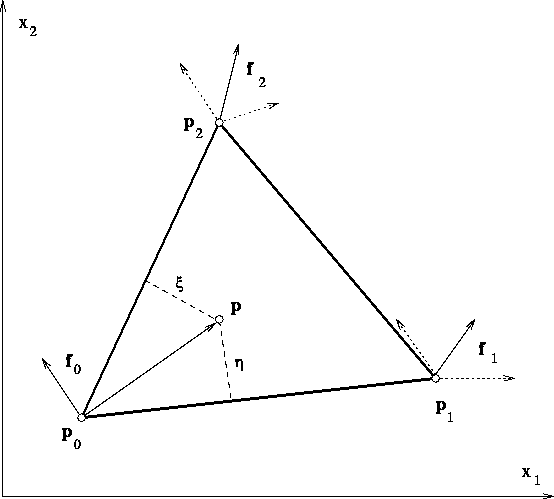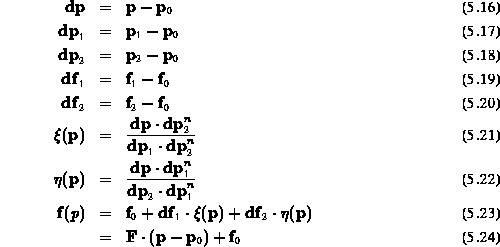 into
an origin (arbitrary point of the simplex) and projections (local
coordinates) as shown in Figure 5.3 for the two-dimensional
case.
into
an origin (arbitrary point of the simplex) and projections (local
coordinates) as shown in Figure 5.3 for the two-dimensional
case.





The first problem (the construction of F)
can be solved without having to
struggle with several algebraic equations by using
an auxiliary decomposition of  into
an origin (arbitrary point of the simplex) and projections (local
coordinates) as shown in Figure 5.3 for the two-dimensional
case.
into
an origin (arbitrary point of the simplex) and projections (local
coordinates) as shown in Figure 5.3 for the two-dimensional
case.

Figure 5.3: A two-simplex (triangle) and the decomposition of
 using local coordinates
using local coordinates

Using these substitutions one readily obtains F by comparison of coefficients

A reasonable method for the numerical computation of  in both the two- and three-dimensional case is to explicitely determine the
eigenvalues and eigenvectors of
in both the two- and three-dimensional case is to explicitely determine the
eigenvalues and eigenvectors of  and use the diagonal
transformation.
and use the diagonal
transformation.

to compute

To this end we must determine the eigenvalues  and eigenvectors of
F. For the two-dimensional case this leads to a quadratic
equation which has two real or conjugate complex solutions, depending
on the
and eigenvectors of
F. For the two-dimensional case this leads to a quadratic
equation which has two real or conjugate complex solutions, depending
on the  . The three-dimensional case is just slightly more
complex, as more cases
must be distinguished for the characteristic equation (which is a
cubic equation).
. The three-dimensional case is just slightly more
complex, as more cases
must be distinguished for the characteristic equation (which is a
cubic equation).
